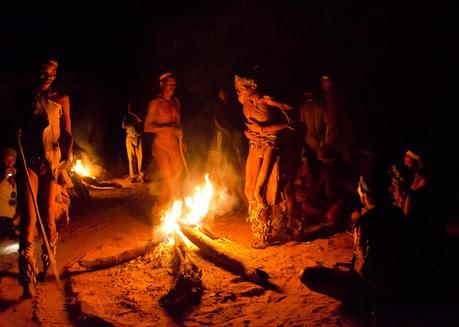Scholars have long been fascinated by the idea that something like the primordial or original “religion” existed until recently among various groups of hunter-gatherers. For cultural evolutionists this amounted to a progression from “primitive” to “modern” religion. The supposed exemplars of such religion were the Australian Aborigines and southern African Bushmen or San. The assumption underlying these views was that the Aborigines and San were frozen in time and that their “religion” did not change (or change much) over time.
We know, of course, that none of this correct — these groups have complex histories of migration, contact, and change. While some may have carried on in ways that more closely resembled ancestral or foraging lifeways, this doesn’t mean their “religions” (a word and concept foreign to most or all of them) are static models of the prehistoric past.
In 1989, Edwin Wilmsen’s Land of the Flies: A Political Economy of the Kalahari ignited a major and acrimonious debate about the history of southern African Bushmen. The particulars of the debate aside, Wilmsen convincingly demonstrated that the San had a more complex history than was supposed and were not pristine exemplars of the ancestral past. On the basis of archaeological evidence, he was able to show that Bushmen had a long history of contact and exchange with Bantu pastoralists and other iron producing societies. Wilmsen estimated that this began ~1,500 years ago.
There is now genetic evidence supporting Wilmsen’s claim. In the abstract to a forthcoming paper, Pickrell and colleagues contend:
The history of southern Africa involved interactions between indigenous hunter-gatherers and a range of populations that moved into the region. Here we use genome-wide genetic data to show that there are at least two admixture events in the history of Khoisan populations (southern African hunter-gatherers and pastoralists who speak non-Bantu languages with click consonants). One involved populations related to Niger-Congo-speaking African populations, and the other introduced ancestry most closely related to west Eurasian (European or Middle Eastern) populations. We date this latter admixture event to approximately 900-1,800 years ago, and show that it had the largest demographic impact in Khoisan populations that speak Khoe-Kwadi languages. A similar signal of west Eurasian ancestry is present throughout eastern Africa. In particular, we also find evidence for two admixture events in the history of Kenyan, Tanzanian, and Ethiopian populations, the earlier of which involved populations related to west Eurasians and which we date to approximately 2,700 – 3,300 years ago. We reconstruct the allele frequencies of the putative west Eurasian population in eastern Africa, and show that this population is a good proxy for the west Eurasian ancestry in southern Africa. The most parsimonious explanation for these findings is that west Eurasian ancestry entered southern Africa indirectly through eastern Africa.
None of this should come as a surprise. Like all other peoples, the San have a complex history and have experienced continuous cultural change (even as their basic mode of production has remained relatively stable). Evidence of that change is not hard to identify when it comes to their so-called “religion.”
Lorna Marshall’s Nyae Nyae !Kung: Beliefs and Rites is the classic source for insights into San worldviews, at least as they existed in the 1950s when the Marshalls did most of their fieldwork. One of the strengths of Marshall’s presentation is that she does not claim that the San beliefs and rituals she recorded were ancient, timeless, pristine, or unchanged. In fact, she several times suggests they are not and some of the beliefs-rituals appear to be old and some new. To her credit, Marshall makes no attempt to date or sort what she calls different “strata” of belief-ritual and refuses to speculate on the issue. What we get is a snapshot of San worldviews in the 1950s that were undergoing — as they always had — continuous and creative change. I strongly suspect that the San had appropriated (and transformed) neighboring culture god-beliefs due to the changing nature of their lifeways and accompanying social stress.
The San seemingly responded to this change and stress by dancing: “During the thirteen months in 1952 1953, from July to July, thirty-nine Ritual Healing Dances took place where we were present” (Marshall 1999:64). Given the intensity of those dances (which often lasted all night), this is quite a lot of dancing for people who otherwise expended a great deal of caloric energy while foraging. Marshall’s comment (p. 63) on the dances is intriguing:
A Healing Dance is the one activity in !Kung life that draws people together in groups that are of considerable size and are not shaped by family, band, close friendship, or ritual exclusions. Nothing but a Healing Dance assembles all the people present into a wholly concerted activity. During the dance no words divide them. In close configuration they clap, sing, and stamp the dancing steps with such coordination and rhythmic precision that they are like one organic being.
This sounds an awful lot like Durkheim. It’s hard to know whether Marshall framed her observations through a Durkheimian lens. Though she was not formally or academically trained as an anthropologist, she knew many anthropologists and worked closely with them. I can’t help but wonder whether they suggested she read Durkheim or conveyed their own Durkheimian views (which would have been disguised as functionalism) to her. If Marshall’s impression of the Healing Dance was wholly her own, it is evidence in favor of social cohesion theory.


